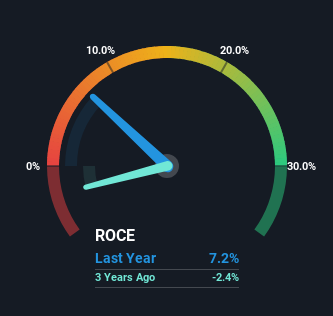Some Investors May Be Worried About Whitbread's (LON:WTB) Returns On Capital
If we want to find a stock that could multiply over the long term, what are the underlying trends we should look for? Amongst other things, we'll want to see two things; firstly, a growing return on capital employed (ROCE) and secondly, an expansion in the company's amount of capital employed. Ultimately, this demonstrates that it's a business that is reinvesting profits at increasing rates of return. Having said that, from a first glance at Whitbread (LON:WTB) we aren't jumping out of our chairs at how returns are trending, but let's have a deeper look.
Understanding Return On Capital Employed (ROCE)
Just to clarify if you're unsure, ROCE is a metric for evaluating how much pre-tax income (in percentage terms) a company earns on the capital invested in its business. The formula for this calculation on Whitbread is:
Return on Capital Employed = Earnings Before Interest and Tax (EBIT) ÷ (Total Assets - Current Liabilities)
0.072 = UK£641m ÷ (UK£9.8b - UK£853m) (Based on the trailing twelve months to August 2023).
So, Whitbread has an ROCE of 7.2%. On its own that's a low return on capital but it's in line with the industry's average returns of 7.0%.
Check out our latest analysis for Whitbread
Above you can see how the current ROCE for Whitbread compares to its prior returns on capital, but there's only so much you can tell from the past. If you'd like, you can check out the forecasts from the analysts covering Whitbread here for free.
What The Trend Of ROCE Can Tell Us
In terms of Whitbread's historical ROCE movements, the trend isn't fantastic. Around five years ago the returns on capital were 12%, but since then they've fallen to 7.2%. Although, given both revenue and the amount of assets employed in the business have increased, it could suggest the company is investing in growth, and the extra capital has led to a short-term reduction in ROCE. If these investments prove successful, this can bode very well for long term stock performance.
Our Take On Whitbread's ROCE
Even though returns on capital have fallen in the short term, we find it promising that revenue and capital employed have both increased for Whitbread. And there could be an opportunity here if other metrics look good too, because the stock has declined 10% in the last five years. So we think it'd be worthwhile to look further into this stock given the trends look encouraging.
Whitbread does have some risks though, and we've spotted 1 warning sign for Whitbread that you might be interested in.
While Whitbread may not currently earn the highest returns, we've compiled a list of companies that currently earn more than 25% return on equity. Check out this free list here.
Have feedback on this article? Concerned about the content? Get in touch with us directly. Alternatively, email editorial-team (at) simplywallst.com.
This article by Simply Wall St is general in nature. We provide commentary based on historical data and analyst forecasts only using an unbiased methodology and our articles are not intended to be financial advice. It does not constitute a recommendation to buy or sell any stock, and does not take account of your objectives, or your financial situation. We aim to bring you long-term focused analysis driven by fundamental data. Note that our analysis may not factor in the latest price-sensitive company announcements or qualitative material. Simply Wall St has no position in any stocks mentioned.

